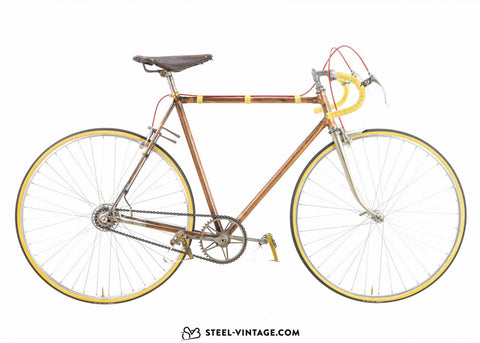The History of Wilier Triestina
In the early 20th Century the bicycle became the most common means of transportation for Italians, thanks to the initiative of pioneers like the shopkeeper and craftsman Pietro Dal Molin from Bassano. He was fascinated by bicycles and the speed with which they were gaining popularity in daily life. Dal Molin decided to get involved in this adventure and play a part in it by opening a small workshop in San Fortunato to manufacture bicycles and so Ciclomeccanica Dal Molin was born.

The iconic Ramata Paintscheme on a Wilier equipped with a Campagnolo 50th Anniversary.
Available Wilier bicycles
Growth of Ciclomeccanica Dal Molin
In Bassano owning one of Molin’s bicycles became fashionable, requests started coming in from far and wide and the modest workshop was expanded and enhanced. Mass production made possible with an industrial facility, kept the costs of the bicycles down and in turn encouraged their progressive distribution. Due to the conflict of the World Wars, the production of bicycles in the San Fortunato facility slowed down, however they did not stop entirely.
With Italy finally free from but exhausted by the war, cycling started to really flourish, particularly thanks to the reports in newspapers and radio that could spread about the duels between Gino Bartali and Fausto Coppi. At the same time sponsorship was becoming a common practice and with the other Italian brands such as; Legnano, Atala and Bianchi already taking this approach Mario Dal Molin decided to do the same.
Birth of Wilier
Ciclomeccanica Dal Molin merged with Veloce Club Bassano in 1945, which created a new force in the professional cycling scene: it wore a red jersey and bore San Giusto's halberd as its emblem. Practically a flag. Ciclomeccanica Dal Molin devised a new sports bicycle and called it Wilier Triestina (W Italia Libera e Redenta ‘hooray for a free and redeemed Italy’). The unmistakable copper reflection of its colour was immediately patented and would become the company's distinguishing feature for decades.
The Ramata Paintwork
Bruno Villari the man in charge of the brand's aesthetics did not want common and overused colours for Wilier, but something different and special. He found the copper plating to be the most appealing and eye-catching, he later experimented with the colour of the copper by mixed dozens of colours, poured and removed diluent, nitrate and white spirit to find a paint that looked like the red of the jersey. However, he found that the material would oxidise and turn green to combat this a translucent paint was applied over the copper plating as soon as the electrolytic process was completed, it would create a weather-proof film that prevented air from attacking the copper, thus retaining the original shine. To make the bikes even smarter and original, Villari thought of enhancing them with a series of golden threads outlining the frame. A sort of lace to make the bike stand out, like in exclusive high fashion garments.
Downfall of Wilier Triestina
In 1952 the decline of Wilier Triestina came quickly and relentlessly when the echo of its maximum glory in sport and business was still resounding. When a business starts going downhill it is usually due to several concomitant factors, but the episode mainly linked with the collapse of the company was an unexpected event that Dal Molin was not able to react to the non-payment of a significant number of bicycles. Numerous cases had been crammed on a merchant's vessel heading for Argentina, like the one featured on the panels that Wilier showed off in fairs and in the company. However, all those bicycles were never paid for and Wilier Triestina, already staggering, ended up on its knees. In 1952 the Dal Molin family sold their ownership to MMM (Meccanica Moderna Milano), which decided to dedicate some departments of the factory in Bassano to assembling Parilla sports motorbikes. A small bicycle production line was maintained at the same time under the Wilier Triestina brand. However, it was just a futile attempt in the unstoppable decline of the company. An entrepreneurial era lasting almost half a century, which at times had been so exciting to become an asset and symbol of Italy, was coming to an end in the history of Ciclomeccanica Dal Molin, later becoming Wilier Triestina. A chapter was closed for good but it would not be the last.
Rebirth of Wilier
Lino and Antonio Gastaldello brothers had heard of Wilier Triestina when they were kids. They loved its legend and felt proud of belonging to the land where it had prospered. They lived in Rossano Veneto, less than ten kilometres from Bassano. Their father, Giovanni, had even worked for Dal Molin. After 17 years of complete disuse, in 1969 the factory in via Colomba was taken over by the Giacetti brothers from Bassano and by Giovanni Longon, a Venetian bicycle salesman. The property still contained a host of machinery and material to build bicycles. Longon proposed to Lino and Antonio Gastaldello that they should buy the brand. They had the skills, knew what to do and were very enthusiastic. The price was a million lire. It was not only about buying a business, rather taking on a challenge, a difficult and hazardous gamble, to give a dead brand life once again after it had shone so brightly. Putting life back in a legend would take a lot of work and all their courage. The Gastaldellos accepted it and the new era of Wilier Triestina was started. All the material that was not necessary to build bicycles was sold and production was moved to via Stazione in Rossano, where the Gastaldellos lived and already worked. The first frames, made completely of stainless steel, were painted in various colours to accommodate market demands, then the decision was taken to restore the original copper shade.
Business was good and the Gastaldello brothers decided to supply their bikes to some performing teams. It was Dino Zandegù, a good racer in the 1950s and 1960s, then sporting director, to convince them to gradually attempt the adventure of professional competition. In 1979 Zandegù put Mecap Hoonved together which had Mario Beccia, Luciano Rossignoli and Sergio Santimaria as its most representative racers.
For Wilier Triestina the time had come to regain the former glory of the brand to a first-class team.
Copper Plated Wilier

Here is an example of a Copper Plated Wilier from the 1940's, Equipped with Campagnolo Cambio Corsa Shifting.
Wilier Tipo La Triestina

Here is an example of a Wilier Tipo La from the 1960's.
Wilier Triestina Gentleman's Sport Bike

This model was built for sportive yet uncompetitive riding. The chain guard and mudguards would keep good clothes clean while the handlebar allowing for an upright more dignified riding position.
Wilier Triestina Ramata

Here is an example of a Wilier Triestina Ramata from 1976.
Wilier Triestina Verdata

Here is an example of a Wilier Triestina Verdata equipped with a Campagnolo 50th Anniversary Groupset.
Wilier Triestina Azzurrata

Here is an example of a Wilier Triestina Azzurrata.
Wilier Triestina Ramata Cronometro TT

Here is an example of a Wilier Triestina Cronometro Time Trial Bike.
Sources: Wilier. (2021). Wilier Triestina the Story. Available: https://wilier.com/story/it/.





